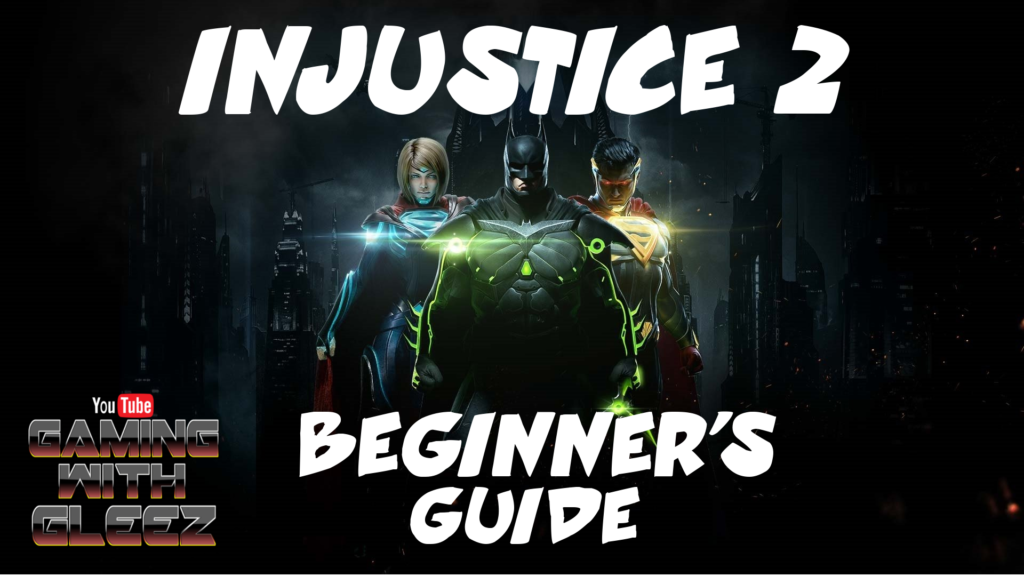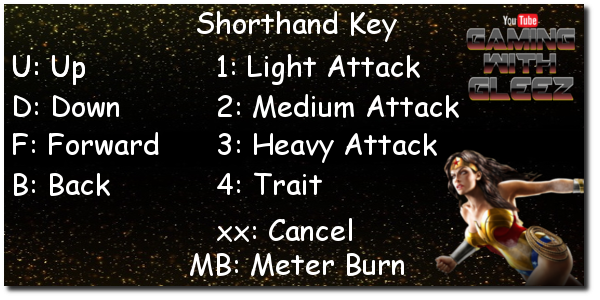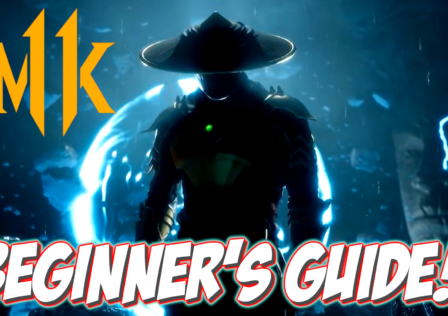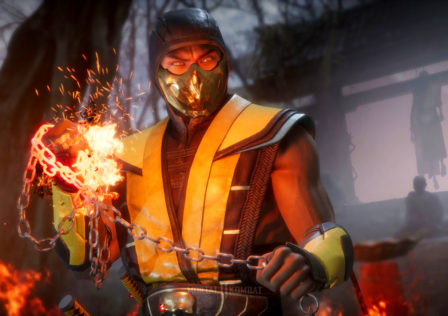In this Injustice 2 Guide For Beginner’s you will learn all of the fundamentals and basics of Injustice 2. This guide will be a great read for those who are new to Injustice 2, because this game is unlike and any other fighting game. Be sure to share this guide with a friend and subscribe to my YouTube channel for more tips and tutorials.
Also, this will be a living guide. That means I will make adjustments to this guide as patches and other gameplay changes come into play. I also will be supplementing sections of this Injustice 2 guide with videos in the future. Be sure to bookmark this page and subscribe to my FREE newsletter as to not miss out on these changes and tips.
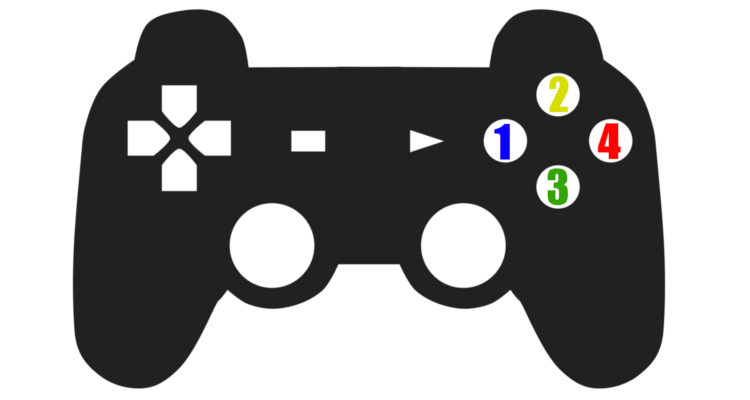 There are four different face buttons that link to an attack in Injustice 2. We label these face buttons 1,2,3 and 4. This allows for a universal language when discussing the game between different systems.
There are four different face buttons that link to an attack in Injustice 2. We label these face buttons 1,2,3 and 4. This allows for a universal language when discussing the game between different systems.
In this section you will find a description of all the basic attacks and their input. For the shoulder buttons, I have listed Playstation 4 first and Xbox One second.
Light Attack (1)
Your fastest attacks are your light attacks. They also deal the least amount of damage in most cases. Crouching light attacks (d1) are typically your fastest poke and most often hits mid.
Medium Attack (2)
Your medium attacks are just that. They do moderate damage and are a bit slower on start up compared to light attacks. Crouching medium attacks (d2) land uppercuts which are good for anti-air conversions and will launch the opponent for a combo.
Heavy attack (3)
Heavy attacks are typically slow but deal heavy damage. Crouching heavy attacks (D3) land sweeps and end in a hard knockdown but are typically unsafe.
Trait (4)
The trait button activates your character’s special ability in Injustice 2. Each character has a different trait with different properties. On activation, some are safe or even plus on block. This means when the trait is activated mid combo, you will recover quicker than your opponent.
For instance, Superman can land his f23 and cancel into trait and will be plus on block. This allows for him to extend his pressure.
On the other hand, Atrocitus is extremely negative when his trait is activated. This forces Atrocitus to “set up” his trait activation. This means he will have to land a specific knock down with a surplus of frames advantage to activate his trait safely.
Each character is different when it comes to their trait. Learn to utilize your favorite character’s trait successfully and maximize it’s potential.
Throw (L1/LB or 1+3)
Throws are great to open up a blocking opponent because they are unblockable. When you grab an opponent you can throw them to the left or right by pressing the corresponding direction. This is great because it can allow you to switch sides and help to give you corner advantage. Throws can be teched in Injustice 2. To tech, or get out of a throw, all you have to do is input the throw buttons on the start up of your opponent’s throw animation.
Stance Switch (L2/LT)
The stance switch flips your character from a left to right handed stance. It also delays your wake up when you are knocked on the ground.
Super (L2+R2 or LT+RT)
Each character has a super that utilizes all 4 bars of meter. In most cases, supers are not ideal. They are good to use to close out a match or maybe to get out of a desperate situation. Many supers are invincible on start up and also cannot be clashed, so they are guaranteed damage.
Interact (R1/RB)
In Injustice 2, interactions with the environment are so important. The interaction button allows you to use your environment to help you in combat. Each character uses their environment a bit differently.
You typically have three different types of characters when it comes to environmental interaction: Power and Gadget characters.
Power Characters utilize their environment for offensive purposes. They pick things up and put them down… on their opponent. Some of these interactions are unblockable.
Gadget characters use their environment to become more mobile. The same interactable objects that a power character may throw, the gadget characters may use to jump toward or away from the opponent. Many of these interactables can also explode if you hold the down direction on the D Pad. These can lead to full combos and are also unblockable.
You can meter burn interactables to add armor as well.
Background Bounce Interactions
In Injustice 2 there are also background interactions that allow you to bounce the opponent off of structures in the environment for a full combo. Each stage has different interactions so master each stage and environment to play Injustice 2 at it’s highest level.
Specials
Each character has a different array of special moves in Injustice 2. These moves all have different characteristics. Be sure to master the special moves for your character of choice.
B3 and F3
B3 and F3 are utilized to launch your opponent and F3 is typically and overhead attack. You can meter burn them (B3 or F3+R2 or RT) to add armor to this move. This added armor comes at the cost of 2 bars. These moves are great for punishing combo gaps or staggers by your opponent.
Your B3 and F3 moves are also unclashable. This means you are guaranteed damage when your opponent is primed to clash mid combo.
Clash (F+MB while in combo)
The Clash is similar to a combo breaker and can only be activated once per match. It also is not available until you are on your second health bar.
The clash works through a meter bar wagering system. The person who wages the most bars will win the clash. The breakdown for the clash reward depends on how many more bars you wager than your opponent and who initiated the clash.
Let’s break down the clash reward.
15%
25%
30%
33%
If you win the clash and you initiated the clash, you gain those percentages back in health.
If you win the clash and you did not initiate it, you take those percentages of health away from your opponent.
Forward Dashing and Back Dashing
A forward dash is a great way to cover a lot of ground quickly. Be careful though, because you cannot cancel the forward dash into block. If you get caught dashing in, the entire dash animation will play out and you may be punished for it.
Back dashes have frames of invincibility. This means that you can get out of strings with gaps or other situations. Back dashes do have recovery frames though and these frames are not invincible. These recovery frames leave you vulnerable to hits while in a sate that you cannot block. Use your back dash wisely.
Meter Burn Roll
For one bar, you can roll almost full screen with your character. You can activate this roll by dashing forward and pressing meter burn (FF+R2 or RT).
The middle portion of the roll is invincible but the start up and recovery frames are not.
The meter burn roll is a great tool to close space, get out of the corner, and to cross your opponent up.
Push Block
The push block is a great tool for getting out of pressure. To execute the push block, press F+Meter Burn while blocking an attack. This is a great way to get out of strings that lead to a mix up.
The push block will create space and reset the neutral. The push block takes one bar of meter to execute so be sure to manage your meter wisely.
Air Tech
The air tech can be done by hitting U+MB or B+MB while being juggled in a combo. This allows your character to flip up or back out of the combo for the cost of two bars of meter. If your opponent anticipates this, they can punish this maneuver.
This move is best used while you are still on your first health bad because the clash is not available to you.
Types of Attacks
In Injustice 2 there are four major types of attacks: Highs, Mids, Lows, and Overheads.
Highs: Highs will be blocked if an opponent is stand blocking and will whiff an opponent that is crouching.
Mids: Mids hit “middle” and can be blocked standing or crouching. In most cases mids will not whiff on crouching opponents because it hits middle.
Lows: Lows can only be blocked low and will hit stand blocking opponents.
Overheads: Overheads must be blocked standing and will hit ducking opponents.
Canceling Moves
You can cancel moves and strings into specials and traits. By canceling a move, you simply input the special move before the initial move ends.
Cross Ups
Injustice 2 is a “back to block” fighting game and because of this cross ups are a major factor in gameplay.
Cross ups force an opponent to guess which side the attack will land. Jump ins are a great way to land a cross up.
Batman is great at this. If you jump in with his medium attack (2) you can aim your jump to land toward the backside of your opponent.
This positioning puts the opponent in a bad spot because they will not know which side the hit will land.
This type of cross up jump in is not limited to Batman. There are other characters that posses this jump-in trait. There are also other ways you can cross your opponent up and this is just the tip of the iceberg when it comes to cross up set ups.
Hard Knockdowns
Hard knockdowns refer to situations where the opponent cannot tech roll. Use hard knockdowns to force your opponent to stay still as they lay on the ground to rise.
Staggering Strings
Staggers are when someone inputs a string and then begins another string because he or she has conditioned you to block. Staggers work best with strings that are neutral, plus or only slightly negative on block. It is also best if the string can be canceled into a special move. Incorporating throws with stagger pressure can be a great way to open your opponent up.
Zoning
Zoning refers to the use of projectile or other attacks that take up big areas or space on the screen.
Superman is a great zoning character because he has a forward advancing combo starts and great projectiles. Space control is important, especially with zoning characters because it allows for you to bait out bad jump ins or dash ins from your opponent and punish them accordingly.
Counter Zoning
Many characters have tools to counter projectile heavy, zoning characters. Teleports, air dashes, and favorable trades are character specific tools that can be utilized once you understand how your character works.
Let’s discuss universal ways around zoning.
Being patient and walking in while crouching projectiles is the best and often times the most over looked way around zoning. Most projectiles hit high so crouching them will allow them to pass right over your head. During your opponent’s recovery frames, walk in and duck the next projectile. Repeat this until you are close enough to attack your opponent.
Meter burn roll is also a great way to get in and close down space. Meter burn rolls will cost you one bar of meter but it can allow you to cut down space in an instant. A well timed meter burn roll can actually catch an opponent on their recovery frames and allow you to combo them and punish their zoning attempts.
Transitions
Each level has a corner that calls for a stage transition. These stage transitions damage your opponent and are triggered when you land B3 close to the corner. The stage transitions can add extra, unclashable damage to your combos.
There is a downside to using a stage transition though. You lose corner positioning.
You may want to refrain from transitioning once you have your opponent cornered because the transition will force you to give up your corner position. The best times to use the transition are when it will kill your opponent or when your opponent is ready to clash with you.
Poke Into Special
In Injustice 2, your D1 poke can link into combo if it is canceled into a special move. Utilize safe specials after pokes to stop your opponent from counter poking. This game plan also has the potential for big combos. This can be a very low, risk high reward tactic.
Tick Throws and Command Grabs
Tick throws are utilized with command grab characters. Command grabs are throws that cannot be teched and because of this it makes grapplers tough to face. Command grabs are also similar to special moves as they have specific inputs associated with them. It is not the same as just hitting the throw button.
A tick throw occurs when a grapple character pokes or attempts a string on block and can immediately follow the blocked pressure up with a command grab. You need to figure out these command grab set ups even if you do not play a grapple character because you will need to identify these set ups mid match. Knowing and understanding what pokes and strings can lead to a tick throw is essential to winning match ups against grapple characters in Injustice 2.
Fuzzy Guarding
Fuzzy guarding is a way to block overhead and low mix ups. The best way to fuzzy guard is to block the fastest combo starter first.
For instance, if the low attack is faster on start up, block low first and try to react to the overhead attack.
By blocking the quicker attack by default, you can adjust your blocking to the slower hit. This will allow you to block overhead and low mix ups more effectively.
This does take practice and will be match up specific, so study each character and know their options and start up frames.
Reading Frame Data
The art of reading frame data is key not only Injustice 2, but any fighting game.
Frame data measures time. The game runs at 60 frames per second so if a move takes 12 frames to become active that means it will take 12/60ths of a second, or 1/5th of a second simplified. Or .2 seconds.
You don’t necessarily need to know the math, but I wanted you to see the breakdown. What you do need to know is how fast moves are in relation to other moves.
Start Up: How long it takes for the move to become active.
Active: The amount of time the move can cause damage to your opponent.
Recovery: How long your character will be in recovery if the move whiffs.
Block Advantage: How many frames it takes for you to gain control of your character in relation to your opponent when the move is blocked.
Hit Advantage: How many frames it takes for you to gain control of your character in relation to your opponent when the move hits.
Cancel: The number of frames you can cancel off the end of the move with a special.
Applying Frame Data
Wake up refers to situations where one opponent is on the ground. There are many options from this spot, and many of them will be character specific. I will cover the universal options from the offensive and defensive perspective.
Defensive Options
Delay Wake Up
You can delay your wake up by holding L2/LT. This causes your character to delay the timing of their rise. This is a great way to punish or force your opponent to commit to a wake up option.
Blocking
Blocking is often overlooked as a wake up option, but it is one of the best options you have. Don’t forget about this option!
Invincible Special Moves
Most characters have special moves that are invincible on wake up. This means the attack will come out and land even if the opponent is attacking. Use these moves wisely because most of them are unsafe and can be punished.
mb B3 or mb F3
Waking up with armor is a decent choice at times. This can land your opponent in full combo and really put you in an advantageous situation.
Before you do this however, know your opponent. Some characters have quick, successive hits and when timed properly can knock out your armored combo starter. This option is match up specific, so be aware.
Tech Roll
By pressing back on wake up, your character can roll backwards. This allows you to change the timing and location of when you rise. Be aware that you cannot tech roll on hard knockdowns. Throughout the game’s life you will begin to understand which moves result in hard knockdowns. Know that everyone’s D3 sweep is a hard knock down. All other hard knock downs are character and move specific.
Throw
If your opponent is playing the wake up situation defensively, a throw is a great option. You can throw forward or backward to get better corner position.
Back Dash
As stated before, back dashes have invincible frames and they can allow you to evade attacks. Be aware that forward advancing moves or strings can catch your back dash on wake up and punish it.
Offensive Options
Meaty Pressure
Pressuring the wake up is when you commit to a string or hit that allows you to continue attacking the opponent. Some characters also have coupling attacks that create 50/50 situations. 50/50s occur when the string leads to an overhead or low and forces the defensive player to make a guess or quick reactionary block.
The term meaty refers to a moves or string that has active frames long enough to force the opponent to block as they rise. If you can land a move on its last few frames, you can create a situation where you may drastically cut down your recovery on block or even be at plus frames. Remember though, Injustice 2 has invincible wake ups, so your opponent may be able to react to your meaty pressure, but it is still a decent option to mix in.
Throw
If the opponent is playing a very defensive wake up you can throw them. Remember you can choose which side you throw to and gain better screen position.
Space the Wake Up
Spacing refers to keeping an ideal distance between you and your opponent. Knowing your opponent’s character and their wake up options is extremely important when trying to space out a wake up.
If your opponent has a short reaching wake up, a quick back dash or walk back can allow you to whiff punish their attack. Study the match ups and know your opponents options to utilize this concept effectively.
Cross Up Jump
If you feel the opponent may try to input a special move, a well times cross up jump will work great. As you jump toward the backside of your opponent, you reverse the inputs on their controller.
This happens because as you jump over, the game registers you as being on the opposite side so it makes it very difficult for your opponent to input their wake up attack. If they block, it also changes the direction they have to press in order to block. If you get good at this, you can make a front side jump in and cross up jump in look very similar and force your opponent to guess.
Block
If you think your opponent will wake up with a special move, blocking is always a great option.
In this section we will cover some of the most important components when learning a new character. These ideas and themes are universal in nature and each character utilizes these components differently.
Normals
Figure out the normals with the quickest start up, most range and best recovery on block. These are the normals you typically will use the most.
D1 is typically the fastest and best poke for characters, but for some characters this may not be true. Blue Beetle for example has a great D3 with lots of range, push back and is safe. It also lands the opponent in a hard knock down. Figure out the normals that are best for your character and game plan around them.
Specials
What specials does this character bring to the table? Are they a zoning character (projectile based), rushdown character (heavy pressure) or are they a grapple character (grabs and throws)?
These are some things to consider based off of the character’s move set. Utilize the tools the character has and practice the special move inputs.
Also keep in mind that unsafe strings can be made safe by canceling them into safe specials.
Trait
What does their trait do? How fast does it refill? How long does it take to start up? Can I cancel attacks into the trait? Is it plus if I do so? Do I need to learn how to set up trait activation because the start up is slow?
These are all things to consider when learning a new character’s trait.
Best Pressure Strings (Combos)
When looking for a great pressure sting, ideally you want one that starts mid, has low recovery on block and can lead to some sort of mix up.
Strings that have great mix up potential hit low or overhead. It is also ideal to find a string that can be canceled into a safe special or trait.
Look for strings that also end plus or have very low recovery on block. When a string is plus you can continue to press buttons after the string is blocked. Unless the string is majorly plus, you will only be able to land a D1. If an opponent respects your D1 after your plus string, you can then throw or even go for moves with longer start ups. Be aware though, the opponent may back dash or MB b3 after the string is blocked as they anticipate you extending the pressure. Be aware of these options and other character specific counters.
Launchers
The universal launchers are b3 and f3, but there are also character specific launchers. Figure out these launch set ups to help maximize damage.
Anti Air Options
Understanding your character’s option to knock people out of the air and maximize damage off of it is key. Do not let an opponent jump in on you for free. Leaving the ground is such a vulnerable time for a character. Make them pay for it as much as possible.
Air To Air Conversions
Many times you will jump at a similar time as your opponent and hit them out of the air. This will create a juggle situation that can often convert into big damage. Learn how to maximize this damage as you master your character of choice.
Fastest Punish
Figure out the character’s fastest start up move in order to punish your opponents unsafe moves. Ideally, try to use a move that links into a combo to maximize the damage of your punish.
Maximize Combo Damage From Different Starters
You can start your combos a multitude of ways. D2, F3, B3, Mid String, Low String, Overhead String, and Air to Airs are typically going to be universal combo starters for the cast. Learn to maximize the damage you can convert off of each of these starters.
Corner Combos
Utilizing the corner with different set ups and starters is crucial. The corner may allow you to link things into combo that you cannot link mid screen. You can also maximize your damage output in the corner with most characters. Ensure you are making the best use of your corner position and learn to maximize the damage of these combos.
I want to thank you for taking the time to read this guide! I will continually be update this Injustice 2 guide and when the game officially drops it will be supplemented with videos. Subscribe to my newsletter to stay up to date with these adjustments!
For more Injustice 2 tips and tutorials be sure to subscribe to my YouTube channel!

